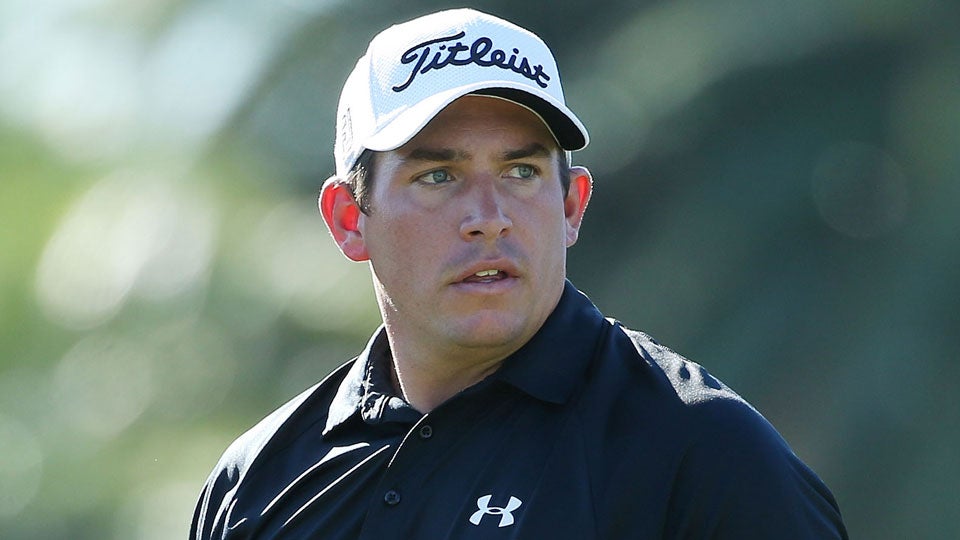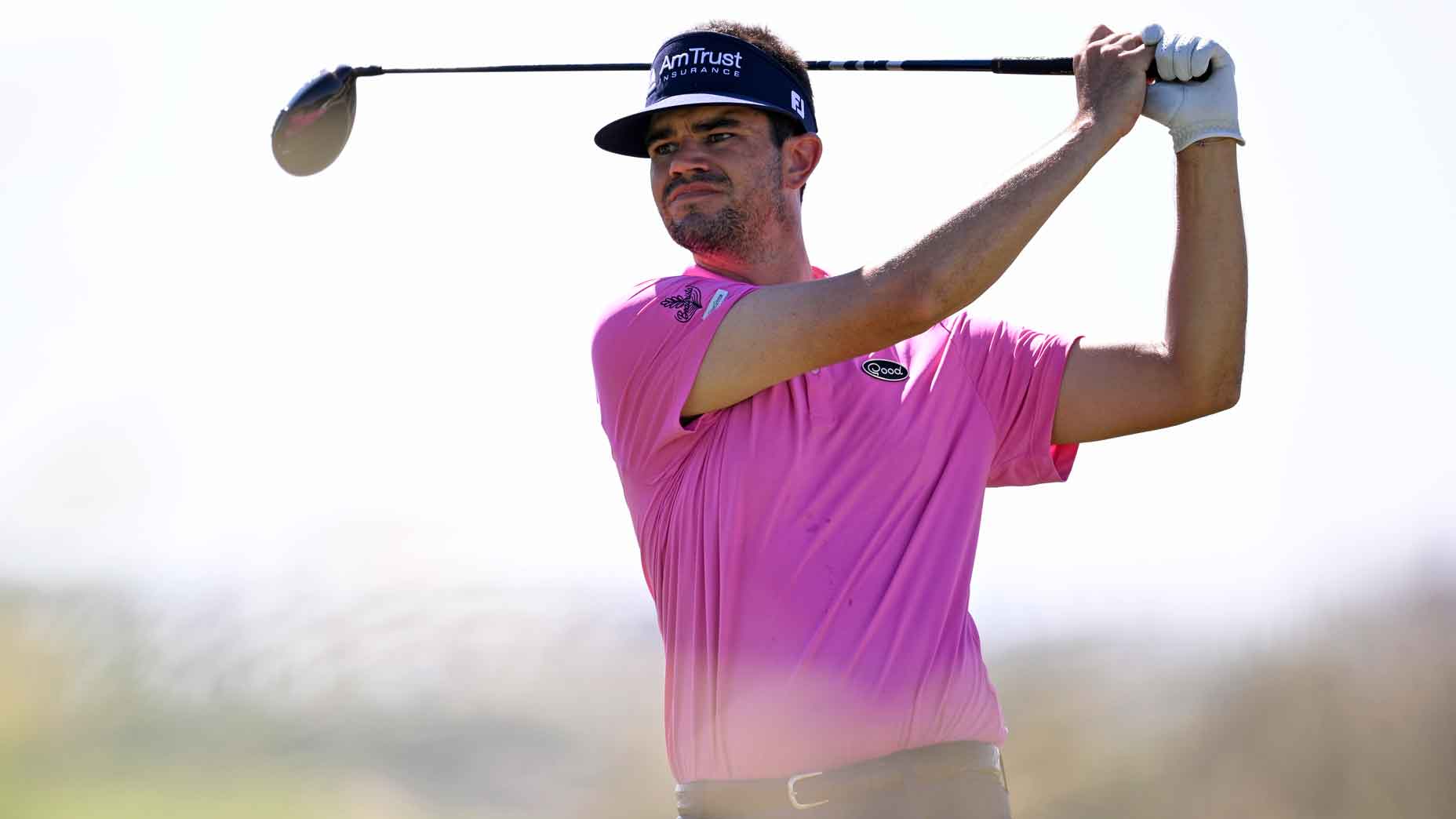Scott Stallings was in trouble. He just didn’t know it yet.
It was April 2015, and the three-time PGA Tour winner had been summoned to meet the most powerful man in golf, Tour commissioner Tim Finchem, in the clubhouse at TPC Louisiana before the start of the Zurich Classic. Stallings would finally have the chance to plead his case in person. Or so he thought.
The golfer reviewed his talking points in his head. He had made a mistake, but he also had immediately reported himself, as golfers are supposed to do, and apologized. Surely, the Tour would forgive him for acting hastily when his health was on the line. Finchem, he thought, would understand.
“I walk into a room, Finchem is there with a few other guys, and before my butt hits the seat, I’m handed a piece of paper telling me I was suspended for three months,” Stallings recalled. “I was very much in shock.”
The decision to make Stallings the newest member of the most exclusive club in golf had already been made. He joined Doug Barron, Vijay Singh and Bhavik Patel as the only players known to have run afoul of the Tour’s Anti-Doping Program since its inception in 2008, his name forever etched on a public naughty list in perhaps the only sport that prizes integrity over success. That culture is so strong that golfers routinely add strokes to their scores for missteps both real and imagined rather than risk the perception that unfair advantages were gained over the field.
That’s exactly what Stallings, a five-year veteran of the Tour, did in February 2015 when he learned that a hormone prescribed by his doctor to help him address a documented medical condition was considered a performance-enhancing drug. “I called a penalty on myself,” Stallings said later. He told the Tour.
In a series of interviews with GOLF.com, however, Stallings said that what happened next shook his faith in the drug-testing policies that regulate Tour competition, the officials that oversee their application and the process by which discipline is meted out.
“I thought the Tour would have my back, but obviously they didn’t,” Stallings said. “I hope no one has to go through it ever again.”
Stallings was sitting in the annual players meeting at the Farmers Insurance Open in February 2015 when he realized he had a problem. Discussion of golf’s return to the Olympics was on the agenda, and Andy Levinson, the Tour’s drug-testing czar, was at the podium urging players to come to him with any questions about the Tour’s anti-doping program.
Stallings had endured a rough year on and off the course. He was the defending champion at that week’s event, but he didn’t feel like it. For the past several months, he had been suffering from what he described as extreme fatigue. “My energy levels were through the floor,” Stallings said. “I couldn’t get out of bed. I lived in a fog.” His results suffered. After winning his third Tour title at Torrey Pines in 2014, Stallings missed 13 cuts in his next 22 starts, his best finish in that stretch a T-32 at the low-wattage FedEx St. Jude Classic.
“I went through a period of two months where I could not tell you a single shot that I hit,” Stallings said. “I was just taking up a spot.”
When his 2014 season ended at the Deutsche Bank Championship outside Boston, Stallings returned to his home in Knoxville, Tenn., and paid a visit to Dr. Raye-Anne Ayo, a local family medicine practitioner. According to a sworn declaration signed by Ayo, a series of blood tests revealed that Stallings’ testosterone level was hovering on the low end of the range of normal, possibly the result of a 2005 surgery in which doctors removed from Stallings a potentially precancerous undescended testicle. Ayo concluded “Stallings’s testosterone level was sub-optimal for him and was possibly contributing to his feelings of fatigue” so she recommended that he take a daily dose of the over-the-counter hormone dehydroepiandrosterone (DHEA) “if it was permissible by the Tour.”
Stallings’ testosterone levels weren’t low enough to garner a diagnosis of hypogonadism, a disorder in which the body produces little to no testosterone, but according to some experts, that doesn’t mean Stallings shouldn’t qualify for medical treatment.
Dr. Abraham Morgentaler, an associate clinical professor of urology at Harvard Medical School and the author of a book called Testosterone for Life, said that there is “a growing awareness that testosterone deficiency is a serious medical condition that profoundly affects men in terms of general health.”
This creates an interesting problem for the Tour and other sports leagues cracking down on doping: where should they draw the line between athletes who are seeking treatment for legitimate medical conditions and those who are trying to enhance their performances?
Stallings’ doctor knew that her patient had to be treated carefully.
“I am aware that Mr. Stallings is a professional golfer on the PGA Tour,” Ayo said in her declaration, “and I took this into account when I evaluated him and recommended treatment, contingent on the approval of the Tour.”

Here’s where Stallings says he made a mistake. He says he went to his local grocery store, purchased a tiny bottle of LifeExtension DHEA for $10.53 and began taking one 25-milligram capsule each morning. He says he never checked the Tour’s Anti-Doping Program Manual. If he had, he might have seen DHEA listed among the anabolic agents prohibited by the Tour. He says he was desperate to feel better and his doctor told him that this was the way.
“My career was the least of my concerns at that point,” Stallings said. “If I play again, awesome. I love my job. It’s what I always wanted to do. But my ability to be a husband and a father was way more important.”
While DHEA is on the list of prohibited substances compiled by the World Anti-Doping Agency, a 2010 study conducted by researchers from the University of Wurzburg in Germany concluded that “the widely perceived performance-enhancing activity of DHEA is still more myth than reality.”
Roger Pielke, a professor at the University of Colorado who studies drug testing and sports governance, said that for many substances prohibited by WADA, including DHEA, “the evidence base is incredibly thin as to what performance benefit they actually have, which raises the question of how much time, effort and money is spent enforcing rules that are just noise.”
Morgentaler dismissed DHEA as a placebo.
“You’d have to be taking a warehouse full of that stuff to have any effect on your muscles,” he said.
Stallings even took a random drug test at the Humana Challenge on Jan. 23, 2015. He says he had been taking DHEA for several weeks. He passed.
After the player meeting at Torrey Pines, however, Stallings checked the list and learned that he had taken a banned substance, so on Feb. 10 he called Levinson’s office and reported himself. He knew that pleading ignorance wouldn’t buy his innocence, but the rules were the rules, and he had broken one. Levinson opened an investigation, and Stallings pledged his cooperation.
Stallings visited the Mayo Clinic in Phoenix when he was in town for the Waste Management Phoenix Open the following week and ordered a full panel of blood work sent to his urologist, Dr. Randall Pearson of Oak Ridge, Tenn., the same doctor who performed the surgery to remove his testicle a decade earlier. Pearson confirmed to GOLF.com that Stallings’ testosterone level was abnormally low, but there wasn’t much he could do for him.
“If he wasn’t a pro golfer, we would have offered him testosterone replacement therapy,” Pearson said. “But with him being on the Tour, you can’t do anything like that.”
The Tour acknowledges “players, like anyone else, may have illnesses or conditions that require the use of a substance on the PGA Tour Prohibited List as treatment.” In those situations, players are invited to apply for a therapeutic use exemption (TUE). The Tour stresses that except in emergency situations, players should not begin treatment until after a TUE has been granted, but as is the case in other aspects of the Tour’s program, the policy has a back door. For a $10,000 fee, players can apply for a “non-emergency retroactive” TUE for medical treatment that might have otherwise resulted in a doping violation.
Stallings might have pursued this avenue, but he knew the Tour didn’t consider his condition a legitimate one. Section 6.C of the Tour’s Anti-Doping Program Manual states that “the use of any Prohibited Substance or Prohibited Method to increase ‘low-normal’ levels of any Endogenous hormone is not considered an acceptable therapeutic intervention.” That left Stallings with little recourse.
He’s not the first golfer with this condition to fall through cracks in the program. Shaun Micheel, the 2003 PGA Championship winner, started taking testosterone in 2004 after experiencing symptoms similar to those described by Stallings. When the Tour announced plans to adopt an anti-doping program in 2008, Micheel applied for a TUE and, though it was eventually granted, he told ESPN in 2009 the process was so “adversarial” that it “just nearly drove [him] out of the game.”
Tour journeyman Doug Barron faced an even tougher battle. Barron had also been prescribed testosterone (and beta blockers for a heart condition), but when he applied for a TUE in 2008, he was denied. When he tested positive for both banned substances the following year, he became the first player suspended by the Tour for violating its anti-doping program. Barron sued under the Americans with Disabilities Act. The lawsuit ultimately was settled, with Barron granted a TUE and permitted to return to competition, though the Tour says he already had served his entire yearlong suspension.
Almost six weeks passed before Stallings received a letter from Levinson notifying him that the Tour had completed its investigation (which included analysis of a sample of LifeExtension DHEA by the WADA-accredited laboratory at UCLA and correspondence with Dr. Ayo) and concluded that Stallings was in violation of the Tour’s Anti-Doping Program.
Stallings says he never was examined or interviewed by the Tour’s medical director, Dr. Thomas Hospel, or any members of its TUE Committee. He also says that none of his doctors were contacted by anyone from the Tour with any medical expertise. They dealt only with Levinson.
Levinson invited Stallings to provide a “written explanation” for consideration before “Commissioner [Finchem], in consultation with the Program Administrator, will … determine whether to impose a sanction.” Under the Tour’s policy, a decision to suspend Stallings would result in a public announcement.
Stallings penned a mea culpa.
“Please know, performance enhancement was never a thought, goal or desire of mine. It was strictly to feel better,” Stallings wrote. “I know the ignorance I displayed is a very poor excuse but its [sic] honest.”
On April 27, Stallings met with Finchem in New Orleans, where he was notified of his suspension. (A copy of that letter can be read below.)
“I thought I would have the opportunity to plead my case, but Finchem has ultimate discretion to do whatever he wants,” Stallings said. “I was surprised by the nonchalance in the way this was handled. The attitude that I got was ‘You should be grateful that you only got three months.'”

According to Stallings’ lawyer, Bill Roach, subsequent meetings with the Tour focused on how news of Stallings’ suspension would be handled, with little concern exhibited for Stallings’ health.
“They just saw it as a simple black and white issue,” Roach said. “They weren’t worried about the medical consequences. They had their policy, they had their admission and they were not open to negotiation.”
In accordance with the Tour’s policy on confidentiality and reporting, the Tour announced, on July 7, that Stallings had self-reported a drug violation and would receive a 90-day suspension. Doping suspensions are the only type of disciplinary action doled out by the Tour that are dislcosed to the public; the Tour disciplines players for recreational drug use and other “conduct unbecoming a professional” in secret. That policy has shielded players like Dustin Johnson, who GOLF.com revealed received a six-month suspension after testing positive for cocaine, from embarrassing public revelations, while Stallings took to the airwaves to explain his “unique situation” to the Golf Channel in a televised interview.
“I felt like I was forced to come forward with a medical issue,” Stallings said. “The policy in regards to the way the Tour handles code of conduct and stuff like that, how recreational drugs are dealt with differently than performance-enhancing drugs, is ridiculous. Players have been caught with something you could go to jail for, but I seem like a bad guy?”
The Tour is notoriously tight-lipped on the subject of its anti-doping program, and the Stallings’ case is no exception.
“The Tour does not discuss a player’s medical information,” PGA Tour spokesman Ty Votaw said. “Under the PGA Tour Anti-Doping Program, a TUE for testosterone supplementation is available for players who meet the clinical diagnosis of hypogonadism as defined by the American Endocrine Society. If a player applies for a TUE, those records are always reviewed by Dr. Thomas Hospel, who serves as TUE Committee chairman. The policy does not allow for a TUE for DHEA.”
Stallings has been left asking questions and, he says, he still hasn’t found answers. Why are recreational drugs and performance-enhancing drugs treated differently? Why did the Tour have to go public with his suspension and not others? Why was he dismissed, despite a wealth of medical documentation, and “made an example of,” as if he had tried to cheat the system?
“The player doesn’t matter,” Stallings said. “I think it was the perfect scenario for them to enforce their policy in close proximity to the Olympics.”
The Tour refutes that assessment.
“This case occurred in early 2015,” Votaw said. “The 2016 Olympic Games had absolutely no bearing on this matter.”
According to Sports Illustrated legal analyst Michael McCann, Stallings’ legal options are limited. He could turn to the Americans with Disabilities Act, as Doug Barron did in 2009, and file a charge of discrimination with the Equal Employment Opportunity Commission, but it would be difficult to bring a successful case against the Tour.
“Even if he has a strong moral or policy argument that the Tour’s drug program ought to be reformed, and even if he has a sensible health argument, Stallings nonetheless agrees to adhere to the Tour’s drug program as a condition of competing on the Tour,” McCann said. “Rather than pursuing a legal claim, Stallings would probably do better to continue to advocate for reform to the drug program and convincing other golfers to support his views.”
Stallings has been feeling better. Recent throat and sinus surgery at the recommendation of a new doctor have alleviated many of the symptoms that had been plaguing him, so his lawyer says any legal challenges to the Tour’s policies have been put on hold for now.
“In terms of what our next steps are with the Tour from a legal standpoint, our position is that Scott has served his suspension, and we’re hoping that he stays healthy and plays great golf,” Roach said. “Obviously, if his health changes, then we’ll have to revisit that stance.”
Stallings is focused on his game, his health and his opportunity to change golf for the better.
“This isn’t about vengeance or spitefulness,” Stallings said. “We can all learn from this. The Tour should use their vast resources to make it so that guys feel like they have a place to come [to receive guidance about their health concerns]. Guys shouldn’t have to contemplate having to retire from professional golf in order to protect their health. I’m very hopeful that the Tour will look at its policies and find ways to make the system better.”
One of Stallings’ doctors, however, lamented that Stallings did this to himself.
“I wish he hadn’t said anything,” Pearson said. “I wish he wasn’t so honest.”






